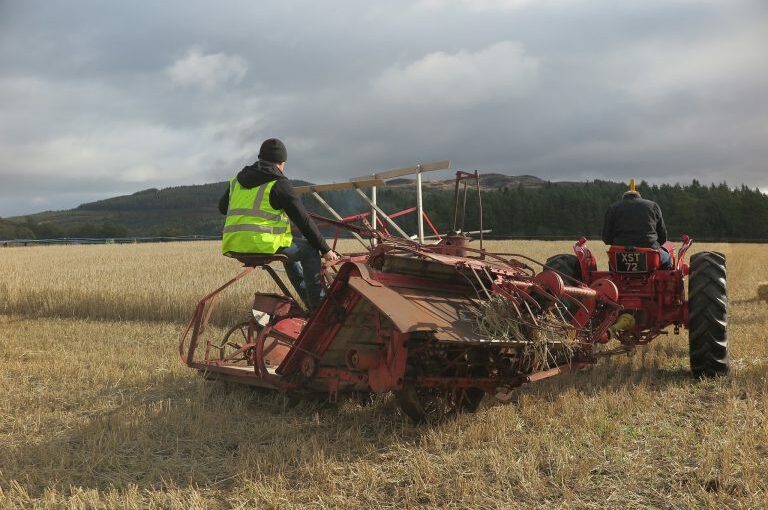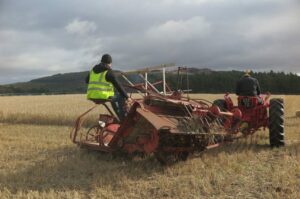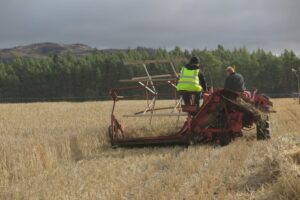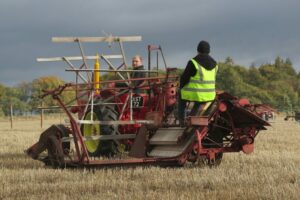Accounts of dinners and other events of the Scottish agricultural implement makers sometimes provide nuggets of information about the history of the makers, the development and introduction of particular implements and machines. One such account was published in The Scotsman of 29 November 1922. It related to a dinner for Mr William Poole of Armstrong & Main (Ltd), Edinburgh. He had been working in the trade since 1871. He played a key role, working for one of the important makers and agents. He had a number of important recollections, including that of the binder into Scotland. This was to play a key role in the mechanisation of the grain harvest. Here is what the newspaper account wrote of that introduction and Mr Poole’s reflections on the implement making sector:
“Scottish implement trade
Introduction of self-binders
Mr William Poole, of Messrs Armstrong & Main (Ltd), Edinburgh, who has been for fifty years associated with Messrs A. & J. Main (Ltd) and Messrs Armstrong & Main, and is a director of the Highland and Agricultural Society and a member of Edinburgh Town Council, was last night entertained at dinner by the Agricultural Implement Trade in Ferguson & Forrester’s, Edinburgh. Mr James H. Steele, Edinburgh, presided, and at the chairman’s table were Councillor Poole, Sir Isaac Connell, S.S.C.; Bailie A. Thornton Hunter, Maybole (Messrs A. Jack & Sons); Mr W. B. Wallace (Messrs Wallace), Glasgow; and Major J. kemp Smith (Messrs kemp & Nicholson), Stirling.
East Lothian demonstrations
Bailie Thornton Hunter, Maybole, in presenting Mr Poole with an illuminated address and other gifts, said much water had run under the bridges since Mr Poole commenced his business life under the late Mr James R. Main in 1871. He often wondered if the agricultural engineer got the credit he was entitled to for inventing and improving machinery to assist the farmer in his endeavour to make the proverbial two blades of grass to grow instead of one. It was admitted that one of the greatest inventions of last century was the self-binder, and Mr Poole’s connections with its introduction in this country was a unique and interesting one. In August 1878, at a field trial of the Walter A. Wood and the McCormick wire binders, he superintended and secured for his firm a gold medal for the McCormick manure. In the early eighties he had the honour of starting eth first twine binder ever put to work in Scotland. This demonstration took place on the farm of Mr Waugh of Eweford, Dunbar. Shortly after this the Toronto binder was introduced into Scotland by the late Mr Wm Ford of Fenton Barns. In the season following the introduction of the Toronto machine, he secured one of four Brantford all-steel frame binders, made by Harris & Son, Brantford. This machine was found to be an improvement on anything that had up to that time been used in this country. It, however, lacked capacity for dealing with the heavy crops grown in this country and it left a long stubble. Quick to see the defects and to know how improvements could be made, Mr Poole met a representative of the makers in the harvest field at Abbey Mains, Haddington, and from the suggestions made by Mr Poole this make of machine was so much improved that it at once jumped into popularity. So great was the success of this binder that the Massey Company found it would be to their interest to amalgamate with Harris & Son, which they did, and their joint production was the world-famous Massey-Harris binder. Mr Poole had contributed in so small measure to the art of agricultural implement making, particularly to the self-binder branch of the art, and a debt of gratitude was due to him by the whole agricultural community for his energy, ability, and enterprise. (Applause)
Importance of agricultural engineer
Mr Poole, in reply, said the manufacture of agricultural machinery in this country gad been looked upon by many as the Cinderella of the engineering profession, but, in his opinion, this was a misconception. In the great countries of the United States, Canada, Australia, New Zealand, Argentine, and South Africa the agricultural engineer occupied a position of pre-eminence, and, in co-operation with the farmer, had helped forward the development of these new countries with a rapidity that otherwise would have been impossible. During the late war the British Government discovered the importance of the agricultural engineer, and the amount of work entrusted to him. Through the manufacture of munitions of war and specialities connected with the same, was simply stupendous; and it must not be forgotten that it was in an agricultural engineering shop at Lincoln that the first war tank was designed and built. Mr Poole referred to the patriotic and valued services of the late Dule of Sutherland in land reclamation, spoke of the valuable assistance which the Scottish agricultural engineer has always received from the Scottish landed proprietors, their factors, and agents, and said that the passing of the landlords at the present time was nothing short of a national calamity. He had been connected with the Highland and Agricultural Society of Scotland since 1873, and with a few exceptions he had been present at the many trials and competitions that had been held under the auspices of the Society, and he had no hesitation in saying that the trials of tractors and tractor implements recently held at Dalkeith were, in his opinion, the most valuable and successful, so far as good and satisfactory work was concerned, that the Society had ever had. (Applause)
A fair field for Scottish agriculturists
Replying to the toast of “Scottish agriculture”, proposed by Mr W. B. Wallace, Glasgow, Sir Isaac Connell said Scottish agriculturists were up against a stiff proposition, but they were not going to lie down to it. They were not going to trust to Government promises or to political proposals. It was their own right hand and their brains on which they had to rely. It was right that the Government should help them with plant breeding, and to combat animal diseases. It was right that they should get the most up-to-date implements. If they got these, and were a fair field, he thought they would win through. (Applause)
Mr P. O. Turnbull, Smeaton, Dalkeith, in proposing the toast of “The Agricultural Implement Trade”, said farmers could not exist without implements, whether they were manufactured in Scotland or not, by they wanted implements which were suited to Scottish conditions.
Mr W. J. Hutchinson, Thurso Engineering Co., replied,
Other toasts included “Our Scottish Capital and its Civil Rulers”, proposed by Mr R. K. Anderson, and replied to by Councillor Philips Smith, and “The Highland and Agricultural Society”, proposed by Mr James Morgan (Messrs George Sellar & Son), and acknowledged by Mr A. B. Leitch, Inchstelly, Alves.’
William Ford of Fenton Barns was involved with the introduction of the binder in Scotland between at least 1887 and 1893. He advertised in the Scottish agricultural press in these years, exhibited at the Royal Highland Show and in 1895 participated in the Royal Highland and Agricultural Society of Scotland’s exhibition of binders at work. He appears to have been earlier a farmer at Hardengreen, Dalkeith.



